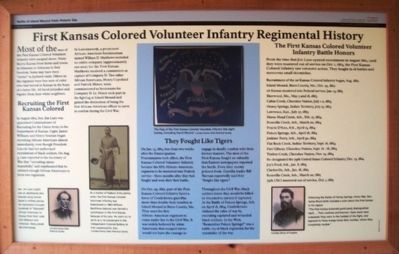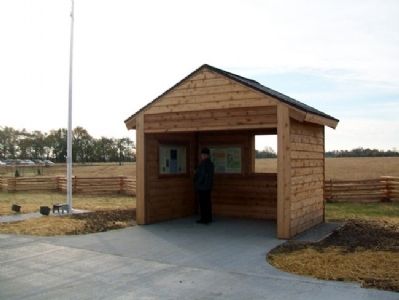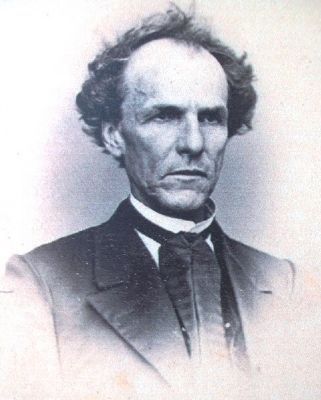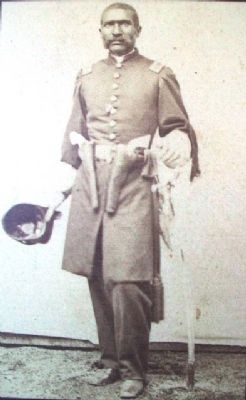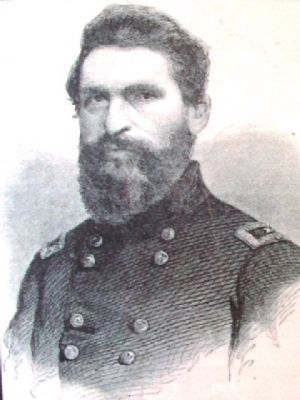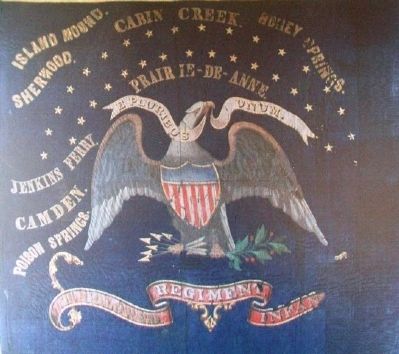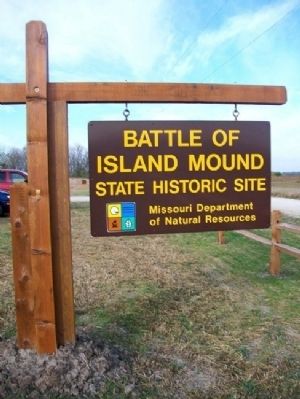Near Butler in Bates County, Missouri — The American Midwest (Upper Plains)
First Kansas Colored Volunteer Infantry Regimental History
Inscription.
Most of the men of the First Kansas Colored Volunteer Infantry were escaped slaves. Many fled to Kansas from farms and towns in Missouri or Arkansas to find freedom. Some may have been "stolen" in Jayhawk raids. Others in the regiment were free men of color who had moved to Kansas in the hope of a better life. All faced prejudice and bigotry from their white neighbors.
Recruiting the First Kansas Colored
In August 1862, Sen. Jim Lane was appointed Commissioner of Recruiting for the Union Army in the Department of Kansas. Capts. James Williams and Henry Seaman began recruiting African Americans almost immediately, even though President Lincoln had not authorized recruitment of black soldiers. On Aug. 5, Lane reported to the Secretary of War that "recruiting opens beautifully," and emphasized that he enlisted enough African Americans to form two regiments.
In Leavenworth, a prominent African-American businessman named William D. Matthews recruited an entire company (approximately 100 men) for the First Kansas. Matthews received a commission as captain of Company D. Two other African Americans, Henry Copeland and Patrick Minor, were commissioned as lieutenants for Company D. Lt. Minor took part in the fighting at Island Mound and gained the distinction of being the first African-American officer to serve in combat during the Civil War.
They Fought Like Tigers
On Jan. 13, 1863, less than two weeks after the Emancipation Proclamation took effect, the First Kansas Colored Volunteer Infantry became the fifth African-American regiment to be mustered into Federal service - three months after they had fought and won their first battle.
On Oct. 29, 1862, part of the First Kansas Colored Infantry faced a force of Confederate guerillas more than double their number at Island Mound in Bates County, Mo. They were the first African-American regiment to come under fire in the Civil War. It was widely believed by white Americans that escaped slaves would not have the courage to engage in deadly combat with their former masters. The men of the First Kansas fought so valiantly that Eastern newspapers reported the battle. Even their enemy praised them. Guerilla leader Bill Turman reportedly said they "fought like tigers."
Throughout the Civil War, black soldiers knew they would be killed or returned to slavery if captured. At the Battle of Poison Springs, Ark. on April 18, 1864, Confederates violated the rules of war by executing captured and wounded black soldiers. In the West, "Remember Poison Springs!" was a battle cry of black regiments for the remainder of the war.
The First Kansas Colored Volunteer Infantry Battle Honors
From the time that Jim Lane opened recruitment in August 1862, they were mustered out of service on Oct. 1, 1865, the First Kansas Colored Infantry saw extensive action. They fought in 16 battles and numerous small skirmishes.
Recruitment of the 1st Kansas Colored Infantry began, Aug. 1862
Island Mound, Bates County, Mo., Oct. 29, 1862
1st Kansas mustered into Federal service, Jan. 13, 1863
Sherwood, Mo., May 5 and 18, 1863
Cabin Creek, Cherokee Nation, July 1-2, 1863
Honey Springs, Indian Territory, July 17, 1863
Lawrence, Kan., July 27, 1863
Horse-Head Creek, Ark., Feb. 17, 1864
Roseville Creek, Ark., March 20, 1864
Prairie D'Ann, Ark., April 13, 1864
Poison Springs, Ark., April 18, 1864
Jenkins' Ferry, Ark., April 30, 1864
Flat Rock Creek, Indian Territory, Sept. 16, 1864
Fort Gibson, Cherokee Nation, Sept. 16-18, 1864
Timber Creek, Cherokee Nation, Nov. 19, 1864
Re-designated the 79th United States Colored Infantry, Dec. 13, 1864
Joy's Ford, Ark., Jan. 8, 1865
Clarksville, Ark., Jan. 18, 1865
Roseville Creek, Ark., March 20, 1865
79th USCI mustered out of service, Oct. 1, 1865
[Photo captions]
[1.] Sen. Jim Lane was an abolitionist who favored using former slaves in military service. His Jayhawkers brought hundreds of "liberated" African Americans to Kansas from
their raids into Missouri and Arkansas. Many joined the First Kansas.
[2.] As a matter of Federal Army policy, when the First Kansas Colored Volunteer Infantry was federalized in 1863 William Matthews was denied a commission in the First Kansas because of his race. He went on to serve as a 1st Lieutenant in the Independent Colored Battery at Fort Leavenworth, Kan.
[3.] Following the Battle of Honey Springs, Union Maj. Gen. James Blunt included a note about the First Kansas in his report: "The First Kansas (colored) particularly distinguished itself;...Their coolness and bravery I have never seen surpassed; they were in the hottest of the fight, and opposed to Texas troops twice their number, whom they completely routed."
Erected by Missouri Dept of Natural Resources.
Topics and series. This historical marker is listed in these topic lists: African Americans • War, US Civil. In addition, it is included in the Former U.S. Presidents: #16 Abraham Lincoln series list. A significant historical month for this entry is March 1870.
Location. 38° 14.194′ N, 94° 26.336′ W. Marker is near Butler, Missouri, in Bates County. Marker is on Marth Road (County Route 1002) near Cooper Road (County Route 5001), on the left when traveling west. Marker is in the kiosk on the grounds of Battle of
Island Mound State Historic Site. Touch for map. Marker is in this post office area: Butler MO 64730, United States of America. Touch for directions.
Other nearby markers. At least 8 other markers are within 6 miles of this marker, measured as the crow flies. The Battle of Island Mound: A Demonstration to the Nation (here, next to this marker); The Battle of Island Mound (here, next to this marker); Battle of Island Mound Memorial (within shouting distance of this marker); The Toothman Farm (about 400 feet away, measured in a direct line); Bates County, Missouri in 1862 (approx. 0.2 miles away); Prairie Fire and the Battle of Island Mound (approx. 0.2 miles away); Replica of the Statue of Liberty (approx. 5.6 miles away); Butler History Murals (approx. 5.9 miles away). Touch for a list and map of all markers in Butler.
Also see . . .
1. The Battle of Island Mound. (Submitted on May 4, 2013, by William Fischer, Jr. of Scranton, Pennsylvania.)
2. First Kansas Colored Infantry. (Submitted on May 4, 2013, by William Fischer, Jr. of Scranton, Pennsylvania.)
3. Battle of Island Mound State Historic Site. (Submitted on May 4, 2013, by William Fischer, Jr. of Scranton, Pennsylvania.)
Credits. This page was last revised on December 15, 2020. It was originally submitted on May 4, 2013, by William Fischer, Jr. of Scranton, Pennsylvania. This page has been viewed 1,096 times since then and 28 times this year. Photos: 1. submitted on May 4, 2013, by William Fischer, Jr. of Scranton, Pennsylvania. 2. submitted on October 28, 2012, by William Fischer, Jr. of Scranton, Pennsylvania. 3, 4, 5, 6. submitted on May 4, 2013, by William Fischer, Jr. of Scranton, Pennsylvania. 7. submitted on October 27, 2012, by William Fischer, Jr. of Scranton, Pennsylvania.
